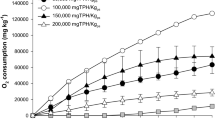Abstract
Large-scale landfarming experiments have been performed on a loamy sand soil. An amount of 1,350 m3/ha oil sludge together with nutrients (N,P,K) and a bacterial inoculum were applied at two different times over a five-year period. At both test periods, biodegradation of the hydrocarbons (HC) was best fitted with first order reaction kinetics with degradation rates ranging from about 4 g HC/kg dry soil per year to about 15 g HC/kg dry soil per year. Toxicity tests on the aqueous soil extracts as well as plant growth and worm tests on the landfarm soil showed no striking negative effects of residual hydrocarbons. Migration of oil, nitrate and phosphate to the groundwater was minimal. In view of the diversity of solvents recommended in the literature, twenty extractants were tested for their capacity to remove HC from the loamy sand soil. Chlorinated solvents, such as dichloromethane and chloroform, were the most effective. Yet, in view of its effectiveness and low toxicity, acetone appears a suitable solvent for the extraction of soils and sediments polluted with hydrocarbons. This case-study revealed that oil sludge can effectively be treated by landfarming, if appropriate technical measures are taken and a sufficient time (minimum 15 years) for bioremediation is provided.
Similar content being viewed by others
References
American Public Health Association (1980) Standard Methods for the Examination of Water and Wastewater. Fifteenth Edition American Public Health Association, New York.
Ames BN, McCann J & Yamaski E (1975) Methods for detecting carcinogens and mutagens with the Salmonella/mammalian mutagenicity test. Mutation Research 31: 347–365
Atlas RM & Bartha R (1973) Stimulated biodegradation of oil slicks using oleophilic fertilizers. Environmental Science and Technology 7: 538–541
Bremner JM & Jenkinson DS (1960) Determination of organic carbon in soil, Journal of Soil Science 1: 394–402
Bulich AA (1979) Use of luminiscent bacteria for determining toxicity in aquatic environments. In: Markings LL & Kimerle RA (Eds) Aquatic Toxicology (pp 89–105). American Society for Testing and Materials, Philadelphia
Centeno MD, Brendonck L & Persoone G (1993) Cyst-based toxicity tests: III. Development and standardization of an acute toxicity test with the freshwater anostacan crustaceanStreptocephalus proboscideus. In: Soares A & Calow P (Eds) Progress in Standardization of Aquatic Tests (pp 37–55). Lewis Publishers, Chelsea, MI 48118
Cottenie A, Verloo M, Velghe G & Kiekens L (1979) Analytical Methods for Plants and Soils. State University Ghent, Belgium
Dibble JT & Bartha R (1979a) Effect of environmental parameters on the biodegradation of oil sludge. Applied and Environmental Microbiology 37: 729–739
Dibble JT & Bartha R (1979b) Rehabilitation of oil-inundated agricultural land: A case history. Soil Science 128: 56–60
Fusey P & Oudot J (1973) Note sur l'accélèration de la biodégradation d'un pétrole brut par les bactéries, Material und Organismen 8: 157–164
Harmsen J (1991) Possibilities and limitations of landfarming for cleaning contaminated soils. In: Hinchee RE & Ollenbuttel RF (Eds) On Site Bioreclamation (pp 255–272). Butterworth-Heinemann Publishing, Stoneham
Hoeks J, Harmsen J & Pennings M (1988) Biologische Reiniging van Grond Vervuild met Gasolie en Ruwe Olie Volgens de Landfarming-Methode. Instituut voor Cultuurtechniek en water-huishouding (ICW report 33), Wageningen, The Netherlands
Kilmer VJ & Alexander LJ (1949) Methods of making mechanical analysis of soil. Soil Science 68: 15–24
Loehr RC, Martin JH & Neuhauser EF (1992) Land treatment of an aged oil sludge loss and change in soil characteristics. Water Research 26: 805–815
Neuhauser EF, Norton RA, Loehr RC & Sillman DY (1989) Earthworm and soil microarthropod responses to oily waste application. Soil Biology and Biochemistry 21: 275–281
OECD Guidelines for Testing of Chemicals (1981) ISBN 92-64-12900-6, OECD Publications, France.
Raymond RL, Hudson JO & Jamison VW (1976) Oil degradation in soil. Applied and Environmental Microbiology 31: 522–535
Schollenberger CJ & Simon RA (1945) Determination of exchange capacity and exchangeable bases in soils, ammonium-acetate method. Soil Science 59: 13–24
Snell TW & Persoone G (1989) Acute toxicity bioassays using rotifers, a fresh water test withBrachionus rubens. Aquatic Toxicology 14: 81–92
Vanloocke R, Verlinde A-M & Verstraete W (1979) Microbial release of oil from soil columns. Environmental Science and Technology 13: 346–348
Verstraete W, Vanloocke R, De Borger R & Verlinde A-M (1980) Modelling of the breakdown and the mobilization of hydrocarbons in unsaturated soil layers. In: Sharpley JM & Kaplan AM (Eds) Proceedings of the Third International Biodegradation Symposium, Applied Science, London (pp 98–112)
Westlake, DWS, Beliek, W, Jobson, A, and Cook, FD (1976) ‘Microbial utilization of raw and hydrogenated shale oils’, Canadian Journal of Microbiology, 22, 239–250
Author information
Authors and Affiliations
Rights and permissions
About this article
Cite this article
Genouw, G., de Naeyer, F., van Meenen, P. et al. Degradation of oil sludge by landfarming — a case-study at the Ghent harbour. Biodegradation 5, 37–46 (1994). https://doi.org/10.1007/BF00695212
Received:
Accepted:
Issue Date:
DOI: https://doi.org/10.1007/BF00695212




